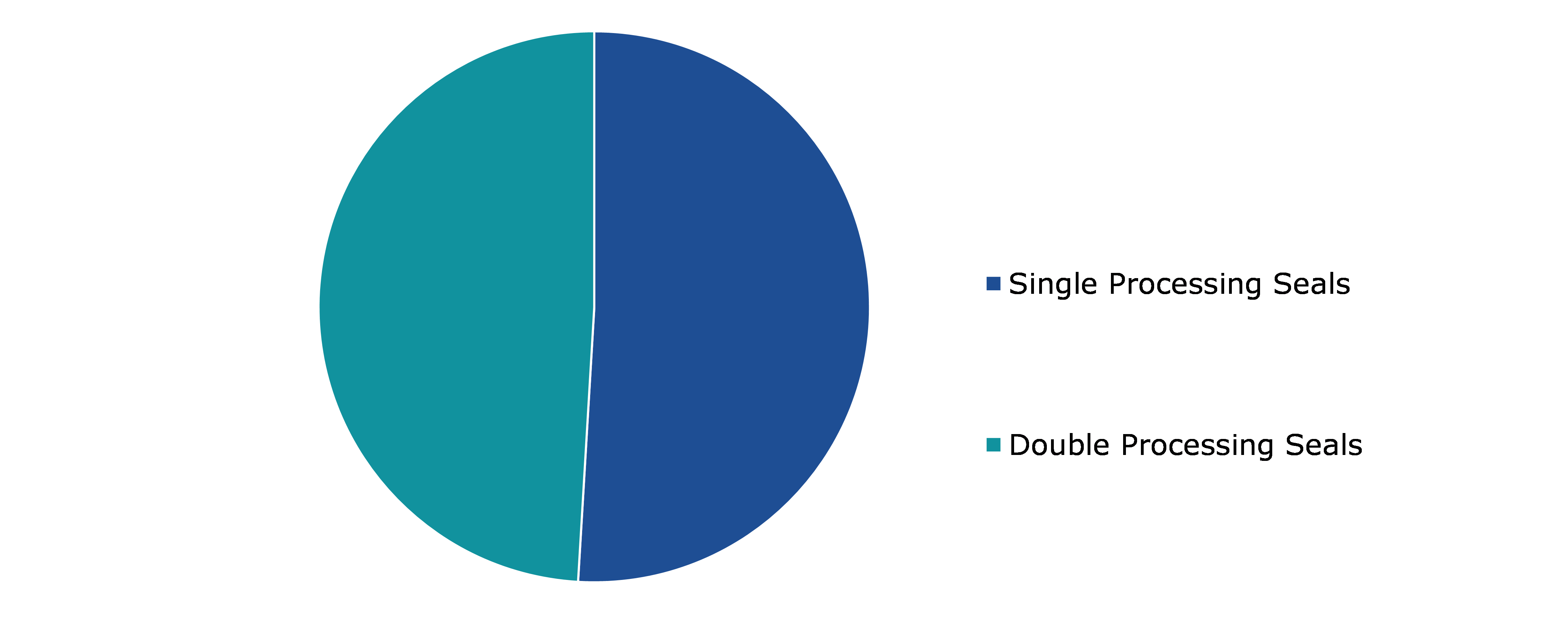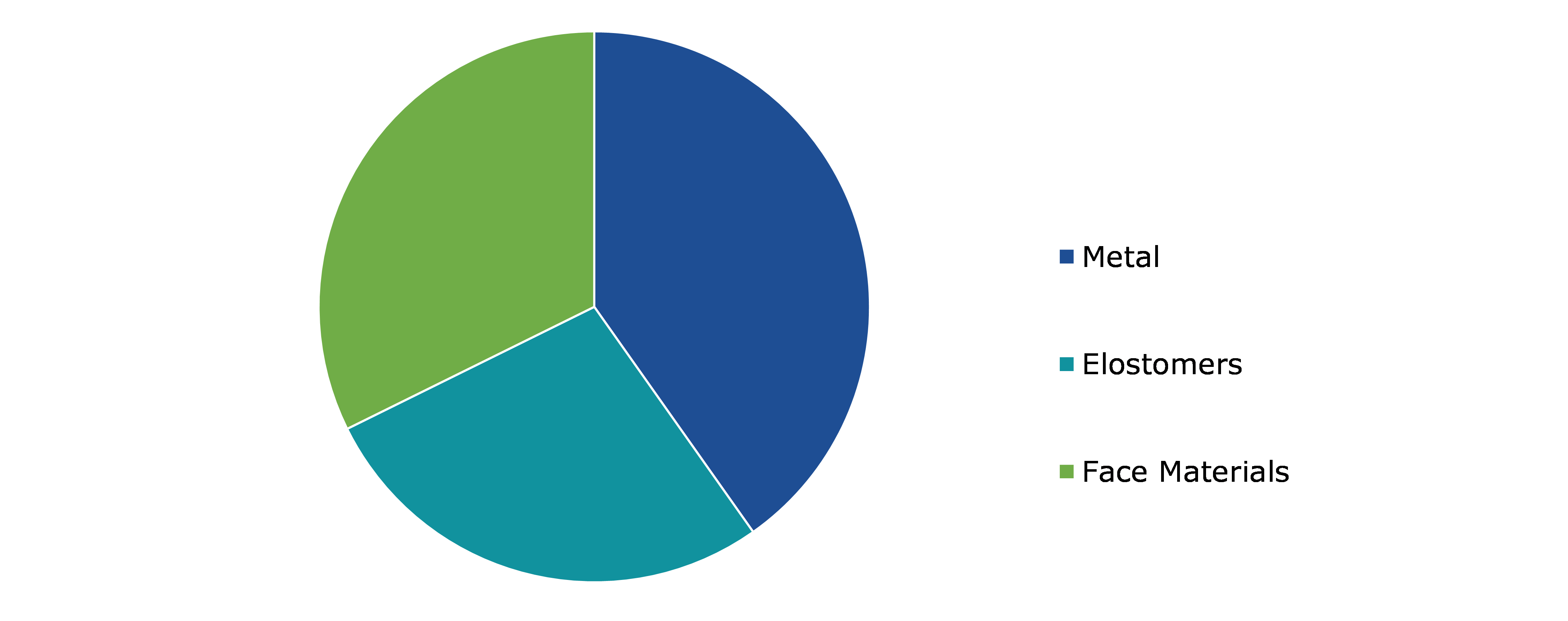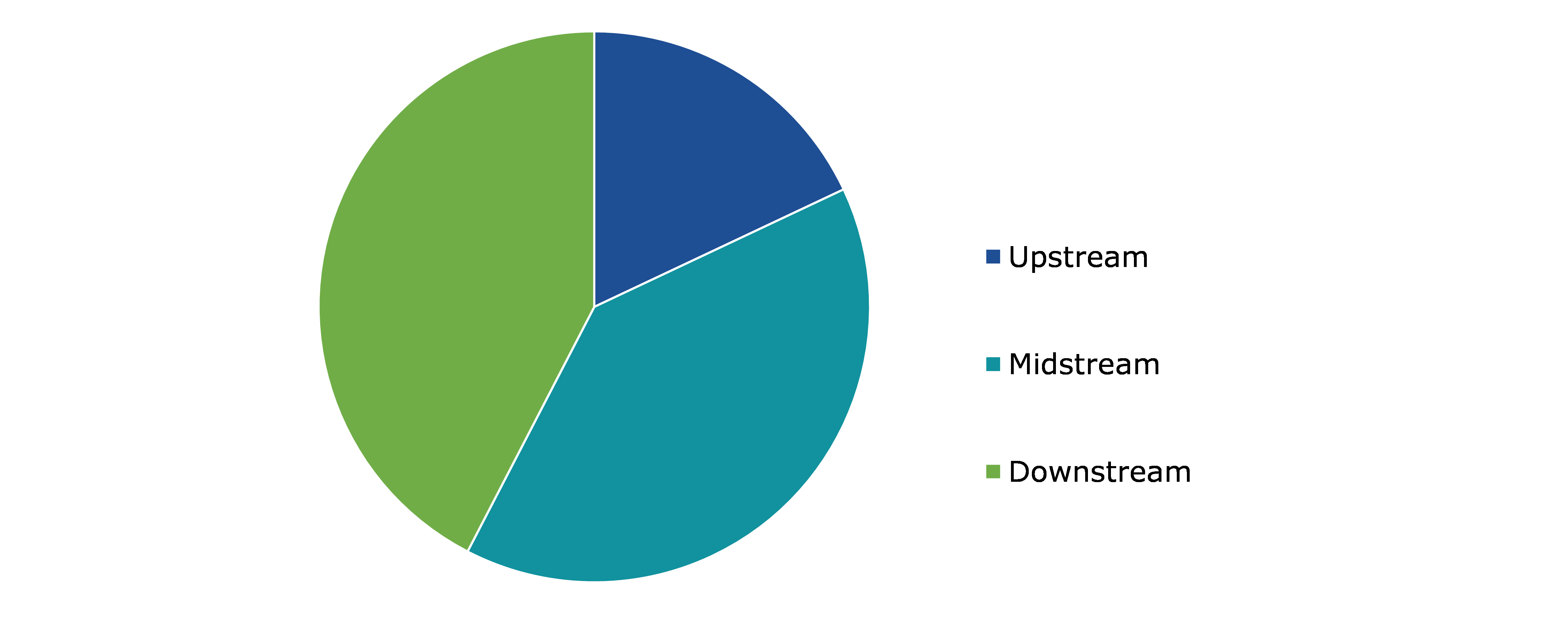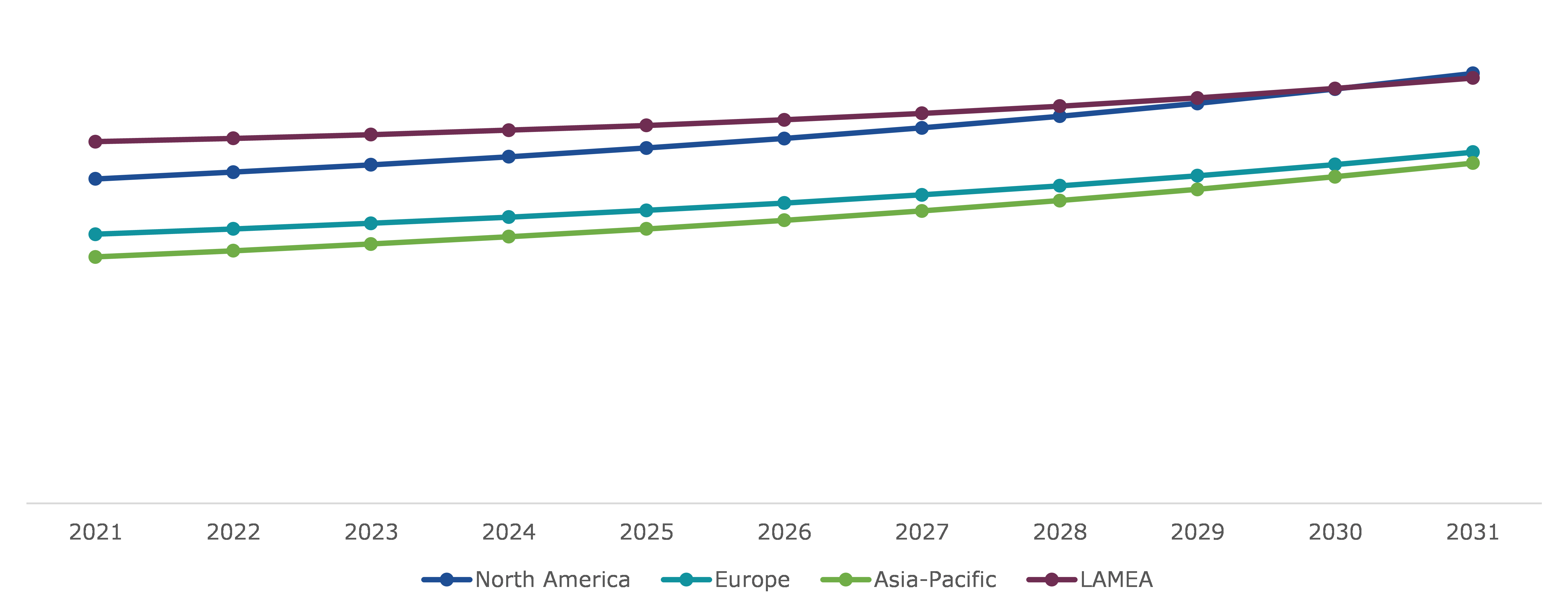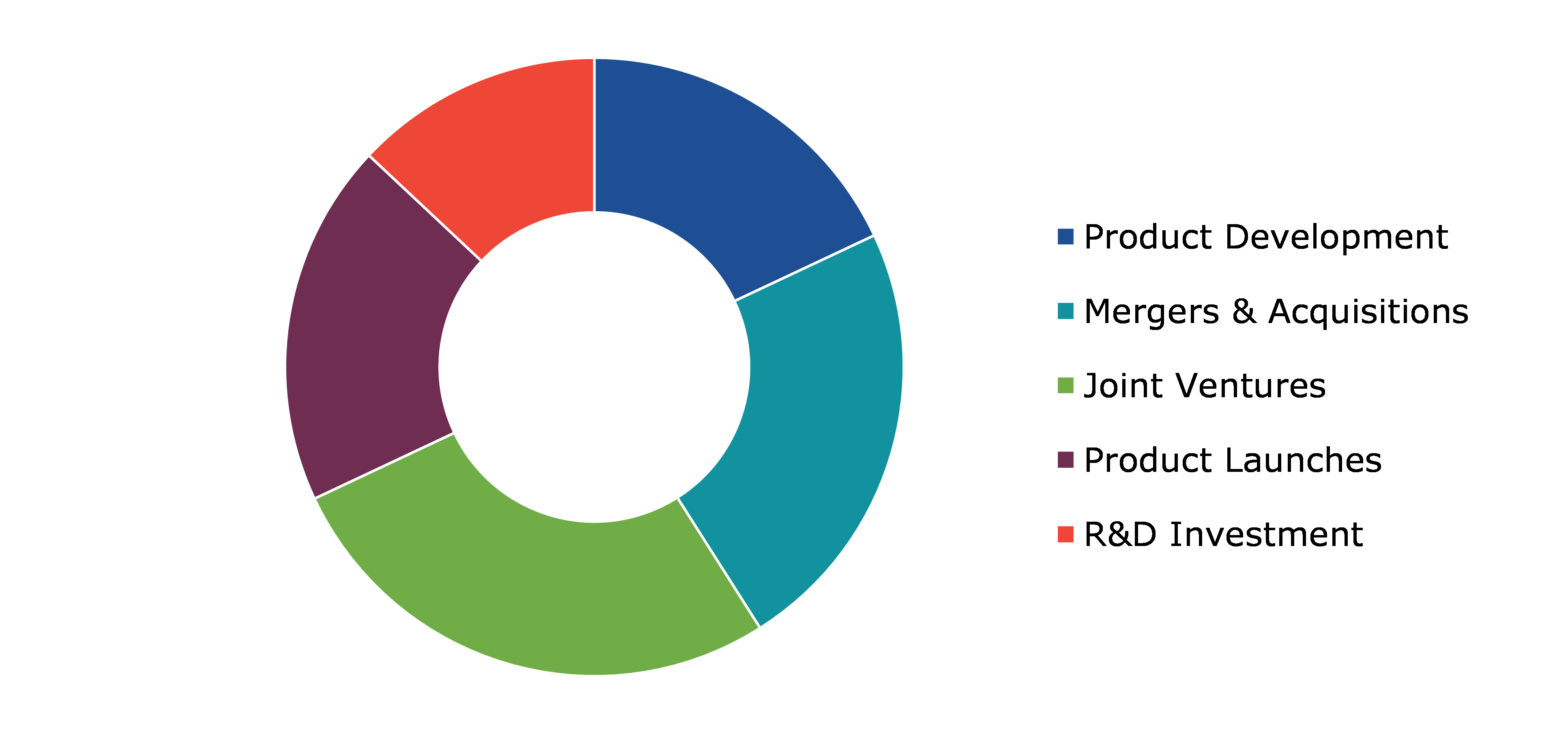Oil & Gas Processing Seals Market Report
RA08621
Oil & Gas Processing Seals Market by Type (Single Processing Seals and Double Processing Seals), Material (Metal, Elastomers, and Face Materials), Application (Upstream, Midstream, and Downstream), and Regional Analysis (North America, Europe, Asia-Pacific, and LAMEA): Global Opportunity Analysis and Industry Forecast, 2022-2031
Global Oil & Gas Processing Seals Market Analysis
The Global Oil & Gas Seals Market Size was $6,299.80 million in 2021 and is predicted to grow with a CAGR of 2.6%, by generating a revenue of $8,110.50 million by 2031.
Global Oil & Gas Processing Seals Market Synopsis
The global oil and seals market has grown owing to substantial investments and oil & gas exploration activities. Several upstream, midstream, and downstream exploration projects have created significant and favorable market growth potential. Another key innovation occurring in this business is digital transformation. Rapidly influencing technology advancements in robotics, artificial intelligence, and IoT have been seen to efficiently streamline exploration activities and supply chains, such as data analytics, robotic drilling equipment operations, and others. These factors are likely to boost the market growth during the forecast period.
External concerns such as severe temperatures, high pressures, and exposure to corrosive fluids have been major causes of concern for oil & gas firms. Growing activities by governmental organizations and, more aggressively, by international bodies toward a greener environment, pushing the adoption of lower-carbon technologies, are influencing the oil & gas sector. These factors are likely to hamper the market growth during the forecast period.
The global oil & gas industry has enormous potential to generate demand for industrial equipment, which is expected to drive the consumption of seals concurrently in the upcoming years. This is because numerous oil & gas projects are already planned for development, while others are still in the planning stages. These are the major factors projected to create several growth opportunities for the key players operating in the market in the future.
According to regional analysis, the LAMEA oil & gas seals market accounted for a dominating market share in 2021. The regional growth is majorly attributed to the presence of many oil & gas companies.
Oil & Gas Processing Seals Market Overview
Oil seals are used to protect shafts and bearings against dirt and foreign object access as well as oil or grease outflow. An oil seal is typically made up of an exterior circular metal portion and an inside flexible member that does the actual sealing and is chemically linked to the metal part. The sealing part is made of rubber, which might be synthetic or natural.
COVID-19 Impact on the Global Oil & Gas Processing Seals Market
The COVID-19 outbreak has impacted numerous businesses, but the oil & gas industry has been the most severely impacted. The spread of the coronavirus forced enterprises to slow operations and in several cases close industrial sites. As a result of the production slowdown, demand for oil & gas processing sealing solutions decreased. The market was hampered by the COVID-19 pandemic, as lockdowns, social distances, and trade sanctions triggered massive disruptions to global supply chain networks. However, the global oil & gas processing sealing business is concentrating on increasing efficiency and productivity, particularly in the Middle East, Africa, and North America in the post-pandemic period.
Growing Number of Exploration Operations Globally to Drive Market Growth
Significant increase in oil & gas exploration operations, as well as the expansion of oil & gas distribution infrastructure around the world, are projected to remain significant drivers for the global oil & gas seals market growth. Apart from the growing number of exploratory initiatives, the business is set to face massive technological upheavals. Furthermore, crude oil production is increasing rapidly around the world, particularly in Asia-Pacific and North America. The demand for oil & gas processing seals is expected to rise in the future as Asia-Pacific’s chemical, petrochemical, and oil & gas industries expand. The petroleum industry is actively attempting to incorporate cutting-edge technologies and production techniques, which is likely to boost the market expansion in countries such as India and China. Globally, over 4 billion metric tons of oil are produced each year, with the Middle East producing roughly one-third of this total.
To know more about global oil & gas seals market drivers, get in touch with our analysts here.
High Prices of Oil & Gas to Restrain Market Growth
The uncertainty surrounding oil & gas prices might cause market reluctance and lead to decreased investment in the industry, which can hamper demand for seals. The oil & gas business is strongly reliant on oil & gas prices, and fluctuations in these prices can have a direct influence on the company's profitability, resulting in a decrease in demand for seals. Volatility in oil & gas prices is a major impediment to the expansion of the oil & gas seals market growth because it has an impact on investment and production operations in the industry.
Technological Advancements and New Product Launches by Major Market Players to Drive the Market Growth
Manufacturers are focusing on developing novel seals that use cost-effective production procedures and innovative raw materials such as elastomers and plastic/polymers with high pressure and temperature resistance standards such as polytetrafluoroethylene, polyetheretherketone, and others. With a growing global awareness of sustainability, oil & gas seal manufacturing businesses are using novel manufacturing techniques and technology. The use of smart precision manufacturing, as well as the availability of raw materials for seal manufacturing, are likely to drive market growth For instance, on August 10, 2022, Inpro/Seal, part of Dover Precision Components and Dover, announced the release of its new magnetic bearing isolator, VBMag, which uses magnetic force to form a liquid-tight seal and defend against lubrication loss and contamination ingress in difficult applications such as flooded, high oil splash, or oil mist conditions.
To know more about global oil & gas seals market opportunities, get in touch with our analysts here.
Global Oil & Gas Processing Seals Market, by Type
By type, the market has been divided into single processing seals and double processing seals. Among these, the single processing seals segment accounted for a dominant market share in 2021 and the double processing seals segment is anticipated to witness the fastest growth during the forecast period.
Global Oil & Gas Processing Seals Market Share, by Type, 2021
Source: Research Dive Analysis
The single processing seals segment accounted for a dominant market share in 2021. A single seal is a device that comprises a single sealing structure that is regarded to have a minimal likelihood of failure when used in accordance with the manufacturer's specifications. A single mechanical seal is made up of two very flat surfaces that are forced together and glide against each other by a spring. A fluid layer formed by the pumped product exists between these two surfaces. This fluid coating keeps the mechanical seal from coming into contact with the stationary ring.
Global Oil & Gas Processing Seals Market, by Materials
By materials, the market has been divided into metal, elastomers, and face materials. Among these, the metal sub-segment accounted for a dominant market share in 2021 and is anticipated to show the fastest growth during the forecast period.
Global Oil & Gas Processing Seals Market Size, by Materials, 2021
Source: Research Dive Analysis
The metal segment accounted for a dominant market share in 2021. When fitted in a housing bore constructed of the same material, metal-cased oil seals are employed. This enables balanced contraction and expansion of the materials during operation, which prevents leakage. Metal-cased seals are typically less expensive than rubber seals.
Global Oil & Gas Processing Seals Market, by Application
By application, the market has been divided into upstream, midstream, and downstream. Among these, the downstream segment accounted for a dominant market share in 2021 and is anticipated to show the fastest growth during the forecast period.
Global Oil & Gas Processing Seals Market Analysis, by Application, 2021
Source: Research Dive Analysis
The downstream segment accounted for a considerable market share in 2021. The increase in the use of seals in the refining of crude oil and the processing and purifying of natural gas at oil refineries and petrochemical plants is attributed to the growth of this segment. Furthermore, it aids in product marketing and distribution. These services aid in the transformation of crude oil into various products such as gasoline, fuel oil, and petroleum-based products.
Global Oil & Gas Processing Seals Market, Regional Insights
The oil & gas seals market was analyzed across North America, Europe, Asia-Pacific, and LAMEA.
Global Oil & Gas Processing Seals Market Size & Forecast, by Region, 2021-2031 ($ Million)
Source: Research Dive Analysis
The Oil & Gas Processing Seals Market in Asia-Pacific to be the Fastest Growing
Asia-Pacific accounted for a dominating oil & gas seals market share in 2021. Accelerated industrialization and increased demand from a variety of end-user sectors are driving market growth in Asia-Pacific. China is a chemical processing powerhouse, accounting for a significant portion of worldwide chemical production. With rising global demand for various chemicals, the need for gaskets and seals in this sector is expected to rise during the forecast period.
Competitive Scenario in the Global Oil & Gas Processing Seals Market
Investment and agreement are common strategies followed by major market players. For instance, in November 2021, John Crane introduced a new addition to the 5600-seal range, the 5610 Liquid Quench (5610L). This extension provides the same benefits as the 5600-seal design but with the addition of a lip seal secondary containment device for liquid quench applications. For liquid quench applications, the 5610L seal design is as reliable and interchangeable as the 5600-seal design.
Source: Research Dive Analysis
The key players profiled in this report include AMG Sealing Limited, BRUSS Sealing Systems GmbH, Cooper Standard, Daetwyler Holding Inc., Dana Limited, ElringKlinger AG, Flowserve Corporation, Freudenberg Sealing Technologies, GARLOCK FAMILY OF COMPANIES, and KLINGER Holding GmbH.
| Aspect | Particulars |
| Historical Market Estimations | 2020 |
| Base Year for Market Estimation | 2021 |
| Forecast Timeline for Market Projection | 2022-2031 |
| Geographical Scope | North America, Europe, Asia-Pacific, and LAMEA |
| Segmentation by Type |
|
| Segmentation by Material |
|
| Segmentation by Application |
|
| Key Companies Profiled |
|
Q1. What is the size of the global oil & gas seals market?
A. The global oil & gas seals market size was $6,299.80 million in 2021 and is predicted to grow with a CAGR of 2.6%, by generating a revenue of $8,110.50 million by 2031.
Q2. Which are the major companies in the oil & gas seals market?
A. Cooper Standard is the key player in the global oil & gas seals market.
Q3. Which region, among others, possesses greater investment opportunities in the future?
A. Asia-Pacific possesses great investment opportunities for investors in the future.
Q4. What will be the growth rate of the North America oil & gas seals market?
A. North America oil & gas seals market is anticipated to grow at a CAGR of 2.9% during the forecast period.
Q5. What are the strategies opted by the leading players in the market?
A. Agreement and investment are the two key strategies opted by the operating companies in this market.
1.Research Methodology
1.1.Desk Research
1.2.Real time insights and validation
1.3.Forecast model
1.4.Assumptions and forecast parameters
1.5.Market size estimation
1.5.1.Top-down approach
1.5.2.Bottom-up approach
2.Report Scope
2.1.Market definition
2.2.Key objectives of the study
2.3.Report overview
2.4.Market segmentation
2.5.Overview of the impact of COVID-19 on Global Oil & Gas Seals market
3.Executive Summary
4.Market Overview
4.1.Introduction
4.2.Growth impact forces
4.2.1.Drivers
4.2.2.Restraints
4.2.3.Opportunities
4.3.Market value chain analysis
4.3.1.List of raw material suppliers
4.3.2.List of manufacturers
4.3.3.List of distributors
4.4.Innovation & sustainability matrices
4.4.1.Technology matrix
4.4.2.Regulatory matrix
4.5.Porter’s five forces analysis
4.5.1.Bargaining power of suppliers
4.5.2.Bargaining power of consumers
4.5.3.Threat of substitutes
4.5.4.Threat of new entrants
4.5.5.Competitive rivalry intensity
4.6.PESTLE analysis
4.6.1.Political
4.6.2.Economical
4.6.3.Social
4.6.4.Technological
4.6.5.Environmental
4.7.Impact of COVID-19 on Oil & Gas Seals market
4.7.1.Pre-covid market scenario
4.7.2.Post-covid market scenario
5.Oil & Gas Seals Market Analysis, by Type
5.1.Overview
5.2.Single Processing Seals
5.2.1.Definition, key trends, growth factors, and opportunities
5.2.2.Market size analysis, by region, 2021-2031
5.2.3.Market share analysis, by country,2021-2031
5.3.Gas Double Processing Seals
5.3.1.Definition, key trends, growth factors, and opportunities
5.3.2.Market size analysis, by region, 2021-2031
5.3.3.Market share analysis, by country,2021-2031
5.4.Research Dive Exclusive Insights
5.4.1.Market attractiveness
5.4.2.Competition heatmap
6.Oil & Gas Seals Market Analysis, by Material
6.1.Metal
6.1.1.Definition, key trends, growth factors, and opportunities
6.1.2.Market size analysis, by region, 2021-2031
6.1.3.Market share analysis, by country,2021-2031
6.2.Elastomers
6.2.1.Definition, key trends, growth factors, and opportunities
6.2.2.Market size analysis, by region, 2021-2031
6.2.3.Market share analysis, by country,2021-2031
6.3.Face Materials
6.3.1.Definition, key trends, growth factors, and opportunities
6.3.2.Market size analysis, by region, 2021-2031
6.3.3.Market share analysis, by country,2021-2031
6.4.Research Dive Exclusive Insights
6.4.1.Market attractiveness
6.4.2.Competition heatmap
7.Oil & Gas Seals Market Analysis, by Application
7.1.Upstream
7.1.1.Definition, key trends, growth factors, and opportunities
7.1.2.Market size analysis, by region, 2021-2031
7.1.3.Market share analysis, by country,2021-2031
7.2.Midstream
7.2.1.Definition, key trends, growth factors, and opportunities
7.2.2.Market size analysis, by region, 2021-2031
7.2.3.Market share analysis, by country,2021-2031
7.3.Downstream
7.3.1.Definition, key trends, growth factors, and opportunities
7.3.2.Market size analysis, by region, 2021-2031
7.3.3.Market share analysis, by country,2021-2031
7.4.Research Dive Exclusive Insights
7.4.1.Market attractiveness
7.4.2.Competition heatmap
8.Oil & Gas Seals Market, by Region
8.1.North America
8.1.1.U.S.
8.1.1.1.Market size analysis, by Type, 2021-2031
8.1.1.2.Market size analysis, by Material, 2021-2031
8.1.1.3.Market size analysis, by Application, 2021-2031
8.1.2.Canada
8.1.2.1.Market size analysis, by Type, 2021-2031
8.1.2.2.Market size analysis, by Material, 2021-2031
8.1.2.3.Market size analysis, by Application, 2021-2031
8.1.3.Mexico
8.1.3.1.Market size analysis, by Type, 2021-2031
8.1.3.2.Market size analysis, by Material, 2021-2031
8.1.3.3.Market size analysis, by Application, 2021-2031
8.1.4.Research Dive Exclusive Insights
8.1.4.1.Market attractiveness
8.1.4.2.Competition heatmap
8.2.Europe
8.2.1.Germany
8.2.1.1.Market size analysis, by Type, 2021-2031
8.2.1.2.Market size analysis, by Material, 2021-2031
8.2.1.3.Market size analysis, by Application, 2021-2031
8.2.2.UK
8.2.2.1.Market size analysis, by Type, 2021-2031
8.2.2.2.Market size analysis, by Material, 2021-2031
8.2.2.3.Market size analysis, by Application, 2021-2031
8.2.3.France
8.2.3.1.Market size analysis, by Type, 2021-2031
8.2.3.2.Market size analysis, by Material, 2021-2031
8.2.3.3.Market size analysis, by Application, 2021-2031
8.2.4.Spain
8.2.4.1.Market size analysis, by Type, 2021-2031
8.2.4.2.Market size analysis, by Material, 2021-2031
8.2.4.3.Market size analysis, by Application, 2021-2031
8.2.5.Italy
8.2.5.1.Market size analysis, by Type, 2021-2031
8.2.5.2.Market size analysis, by Material, 2021-2031
8.2.5.3.Market size analysis, by Application, 2021-2031
8.2.6.Rest of Europe
8.2.6.1.Market size analysis, by Type, 2021-2031
8.2.6.2.Market size analysis, by Material, 2021-2031
8.2.6.3.Market size analysis, by Application, 2021-2031
8.2.7.Research Dive Exclusive Insights
8.2.7.1.Market attractiveness
8.2.7.2.Competition heatmap
8.3.Asia-Pacific
8.3.1.China
8.3.1.1.Market size analysis, by Type, 2021-2031
8.3.1.2.Market size analysis, by Material, 2021-2031
8.3.1.3.Market size analysis, by Application, 2021-2031
8.3.2.Japan
8.3.2.1.Market size analysis, by Type, 2021-2031
8.3.2.2.Market size analysis, by Material, 2021-2031
8.3.2.3.Market size analysis, by Application, 2021-2031
8.3.3.India
8.3.3.1.Market size analysis, by Type, 2021-2031
8.3.3.2.Market size analysis, by Material, 2021-2031
8.3.3.3.Market size analysis, by Application, 2021-2031
8.3.4.Australia
8.3.4.1.Market size analysis, by Type, 2021-2031
8.3.4.2.Market size analysis, by Material, 2021-2031
8.3.4.3.Market size analysis, by Application, 2021-2031
8.3.5.South Korea
8.3.5.1.Market size analysis, by Type, 2021-2031
8.3.5.2.Market size analysis, by Material, 2021-2031
8.3.5.3.Market size analysis, by Application, 2021-2031
8.3.6.Rest of Asia-Pacific
8.3.6.1.Market size analysis, by Type, 2021-2031
8.3.6.2.Market size analysis, by Material, 2021-2031
8.3.6.3.Market size analysis, by Application, 2021-2031
8.3.7.Research Dive Exclusive Insights
8.3.7.1.Market attractiveness
8.3.7.2.Competition heatmap
8.4.LAMEA
8.4.1.Brazil
8.4.1.1.Market size analysis, by Type, 2021-2031
8.4.1.2.Market size analysis, by Material, 2021-2031
8.4.1.3.Market size analysis, by Application, 2021-2031
8.4.2.Saudi Arabia
8.4.2.1.Market size analysis, by Type, 2021-2031
8.4.2.2.Market size analysis, by Material, 2021-2031
8.4.2.3.Market size analysis, by Application, 2021-2031
8.4.3.UAE
8.4.3.1.Market size analysis, by Type, 2021-2031
8.4.3.2.Market size analysis, by Material, 2021-2031
8.4.3.3.Market size analysis, by Application, 2021-2031
8.4.4.South Africa
8.4.4.1.Market size analysis, by Type, 2021-2031
8.4.4.2.Market size analysis, by Material, 2021-2031
8.4.4.3.Market size analysis, by Application, 2021-2031
8.4.5.Rest of LAMEA
8.4.5.1.Market size analysis, by Type, 2021-2031
8.4.5.2.Market size analysis, by Material, 2021-2031
8.4.5.3.Market size analysis, by Application, 2021-2031
8.4.6.Research Dive Exclusive Insights
8.4.6.1.Market attractiveness
8.4.6.2.Competition heatmap
9.Competitive Landscape
9.1.Top winning strategies, 2021
9.1.1.By strategy
9.1.2.By year
9.2.Strategic overview
9.3.Market share analysis, 2021
10.Company Profiles
10.1.AMG Sealing Limited
10.1.1.Overview
10.1.2.Business segments
10.1.3.Product portfolio
10.1.4.Financial performance
10.1.5.Recent developments
10.1.6.SWOT analysis
10.2.BRUSS Sealing Systems GmbH
10.2.1.Overview
10.2.2.Business segments
10.2.3.Product portfolio
10.2.4.Financial performance
10.2.5.Recent developments
10.2.6.SWOT analysis
10.3.Cooper Standard
10.3.1.Overview
10.3.2.Business segments
10.3.3.Product portfolio
10.3.4.Financial performance
10.3.5.Recent developments
10.3.6.SWOT analysis
10.4.Daetwyler Holding Inc.
10.4.1.Overview
10.4.2.Business segments
10.4.3.Product portfolio
10.4.4.Financial performance
10.4.5.Recent developments
10.4.6.SWOT analysis
10.5.Dana Limited
10.5.1.Overview
10.5.2.Business segments
10.5.3.Product portfolio
10.5.4.Financial performance
10.5.5.Recent developments
10.5.6.SWOT analysis
10.6.ElringKlinger AG
10.6.1.Overview
10.6.2.Business segments
10.6.3.Product portfolio
10.6.4.Financial performance
10.6.5.Recent developments
10.6.6.SWOT analysis
10.7.Flowserve Corporation
10.7.1.Overview
10.7.2.Business segments
10.7.3.Product portfolio
10.7.4.Financial performance
10.7.5.Recent developments
10.7.6.SWOT analysis
10.8.Freudenberg Sealing Technologies
10.8.1.Overview
10.8.2.Business segments
10.8.3.Product portfolio
10.8.4.Financial performance
10.8.5.Recent developments
10.8.6.SWOT analysis
10.9.GARLOCK FAMILY OF COMPANIES
10.9.1.Overview
10.9.2.Business segments
10.9.3.Product portfolio
10.9.4.Financial performance
10.9.5.Recent developments
10.9.6.SWOT analysis
10.10.KLINGER Holding GmbH
10.10.1.Overview
10.10.2.Business segments
10.10.3.Product portfolio
10.10.4.Financial performance
10.10.5.Recent developments
10.10.6.SWOT analysis
11.Appendix
11.1.Parent & peer market analysis
11.2.Premium insights from industry experts
11.3.Related reports
Increasing oil & gas exploration activities, as well as global infrastructure growth for oil & gas distribution, are boosting the need for efficient seals in the oil & gas industries. Oil seals are used to prevent oil or grease from leaking out while also preventing dirt and foreign objects from getting into shafts and bearings. An oil seal is usually composed of an outside circular metal section and an inside flexible component that seals the oil and is chemically bonded to the metal part. The sealing component is made of rubber, either synthetic or natural.
Increasing efforts by governmental organizations to boost the adoption of low-carbon technologies to create a greener world are projected to boost the oil & gas processing seals market growth. The petroleum sector is actively working to adopt cutting-edge technologies and manufacturing methods, which is probably going to support the market expansion in nations like China and India. Additionally, worldwide production of crude oil is rising quickly, especially in North America and Asia-Pacific. All these factors are propelling the demand for oil & gas processing seals in several industries.
Newest Insights in the Oil & Gas Processing Seals Market
With an increasing worldwide awareness about sustainability, oil and gas seal manufacturing companies are employing cutting-edge seal manufacturing techniques and technology, which is boosting the oil & gas processing seals market. As per a report by Research Dive, the global oil & gas processing seals market is anticipated to surpass a revenue of $8,110.50 million in the 2022–2031 timeframe. The Asia-Pacific region is predicted to experience rapid growth in the years to come. This is because of the rapid industrialization, increasing chemical demand, and the rising requirement for gaskets and seals in oil & gas industries in the region.
How are Market Players Responding to the Rising Demand for Oil & Gas Processing Seals?
Market players are expanding their product offerings, improving product quality, increasing production capacity, and collaborating with other market players to cater to the rising demand for oil & gas processing seal solutions. Some of the foremost players in the oil & gas processing seals market are BRUSS Sealing Systems GmbH, AMG Sealing Limited, Daetwyler Holding Inc., Cooper Standard, ElringKlinger AG, Dana Limited, Freudenberg Sealing Technologies, Flowserve Corporation, KLINGER Holding GmbH, GARLOCK FAMILY OF COMPANIES, and others. These players are focused on implementing strategies such as mergers and acquisitions, novel developments, collaborations, and partnerships to reach a leading position in the global market. For instance:
- In October 2018, John Crane, a world pioneer in rotating equipment solutions, offering process industries engineered technologies and services, announced the launch of its most recent gas seal technology, which is intended to be retrofitted into centrifugal compressors using oil seals to significantly minimize operating costs, increase reliability, and reduce methane emissions by up to 95%.
- In November 2021, John Crane, announced the arrival of its innovative 5610 Liquid Quench (5610L), a series of 5600 seal extensions.
- In October 2022, Torrent Gas Ltd., one of India's top brands committed to its objective of improving people's lives by addressing two of their most pressing needs: healthcare and power, announced a plan to spend Rs. 8,000 crores (US$ 1.1 billion) over the next five years to increase its urban gas operations and install 500 CNG dispensing pumps by 2023. Such significant advancements are promoting the growth of prominent oil & gas seal manufacturers around the globe.
COVID-19 Impact on the Global Oil & Gas Processing Seals Market
The unpredicted rise of the coronavirus pandemic in 2020 adversely impacted the global oil & gas processing seals market. The COVID-19 epidemic caused significant disruptions to the world's supply chain networks, which affected the market. These disruptions were brought on by social distance, lockdowns, and trade penalties. The outbreak of the coronavirus forced businesses to slow down and, in some situations, close industrial sites. As a result, the demand for oil and gas processing sealing solutions greatly declined. However, in the post-pandemic period, the oil & gas processing seals market is expected to experience massive growth, as the market is focusing on boosting production and efficiency particularly in Africa, the Middle East, and North America.
Personalize this research
- Triangulate with your own data
- Request your format and definition
- Get a deeper dive on a specific application, geography, customer or competitor
- + 1-888-961-4454 Toll - Free
- support@researchdive.com


